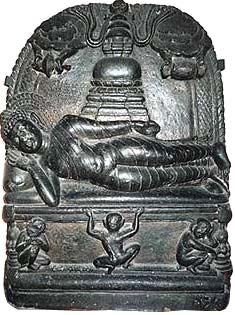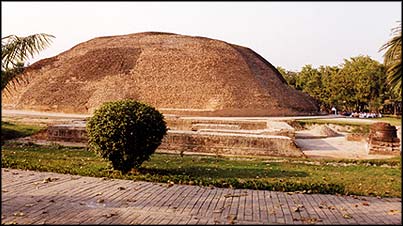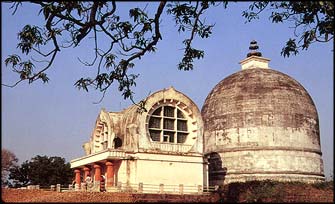Kusinara - place of the Great Passing Away

The Buddha’s last days are described in the Pali text called the Great Parinirvana Sutra (Parinirvana meaning “completed nirvana”). The Buddha’s living nirvana, achieved during enlightenment, at death transforms to nirvana without human residue. Self possessed, without psychological pain, untroubled by the thoughts of death, the Buddha identifies four places of future pilgrimage: the sites of his birth, enlightenment, first sermon, and death. “But don’t hinder yourself by honouring my remains,” he added.
On reaching the village of Kusinara of the Mallas on the further side of the Hiranyavati river, the Buddha realised that his end was fast approaching. He told Ananda to prepare a bed for him with its head turned towards the north between two sal trees. Ananda who served him for 20 years was deeply upset. “Don’t grieve, Ananda!” the Buddha consoles him. “The nature of things dictates that we must leave those dear to us. Everything born contains its own cessation. I too, Ananda, am grown old, and full of years, my journey is drawing to its close, I am turning 80 years of age, and just as a worn-out cart can only with much additional care be made to move along, so too the body of the Buddha can only be kept going with much additional care”.
As desired by the Buddha, the Mallas of Kusinara were informed of his impending death, and they came to pay respects to him. Among them was a mendicant named Subhadra, a 120 year old Brahmin. He had earlier been turned away by Ananda but when the Buddha overheard this he called the Brahmin to his side. He was admitted to the Sangha (Buddhist order) and immediately after his conversion he passed away.

The Ramabhar Stupa: The Buddha’s cremation place, Kusinara.
When the third quarter of the night approached, the Buddha asked his disciples three times if there were any doubts about the teachings or the disciplines. The Bhikkhus stood silent. “Not one, Ananda, has misgivings. All will eventually reach enlightenment.
The Buddha then said his final words, “Listen, Bhikkhus, I say this: all conditioned things are subject to decay, strive with diligence for your liberation”.
He then passed into meditational absorptions and entered Mahaparinirvana (the great passing away). It was the full moon of the month of Vaisakha (April-May) and the year was probably between 487 and 483 B.C. However, according to the Sri Lankan tradition and other southeastern countries, it is believed that the Buddha entered Parinirvana in 544-543 B.C.
For the next six days the body of the Great Master was laid in state. Preparations were made for his funeral under the direction of Anirudha a cousin and follower of the Buddha. On the seventh day, after honouring the body with perfumes and garlands, it was taken to the Mukutbandhana Chaitya, the sacred shrine of the Mallas. The last ceremony was performed by Maha Kasapa and the body of the Great Master was cremated with due honour. When the cremation was completed the ashes were collected by the Mallas as relics, which consisted of a skull bone, teeth and inner and outer shrouds. The relics were then distributed into eight shares amongst the representatives of the other eight Kingdoms which constituted ancient northern India. These relics were again subdivided after King Ashoka decided to build 84,000 stupas. Today these relics are enshrined in stupas across Asia.
On the front of the couch are three sculptures, believed to represent Ven. Ananda near the feet, Ven. Subhadda at the middle and Ven. Dabba Malla at the corner. At the centre is an inscriptionof the 5th century AD, which states the statue was “a gift of the monk Haribala of the Mahavihara and was fashioned by Dinna”. This 1500-year old reclining Buddha image was executed out of one block of red sandstone brough in from Mathura during the Gupta period. It was discovered in 1876 in a dilapidated condition and the scattered fragments were successfully pieced together.

Excavation showed that the original temple on the site consisted of an oblong hall and antechamber with its entrance facing the west. Large number of bricks with carved surfaces found among the rubbish indicated that the temple had a barrel-vaulted roof not unlike that on the modern temple.

